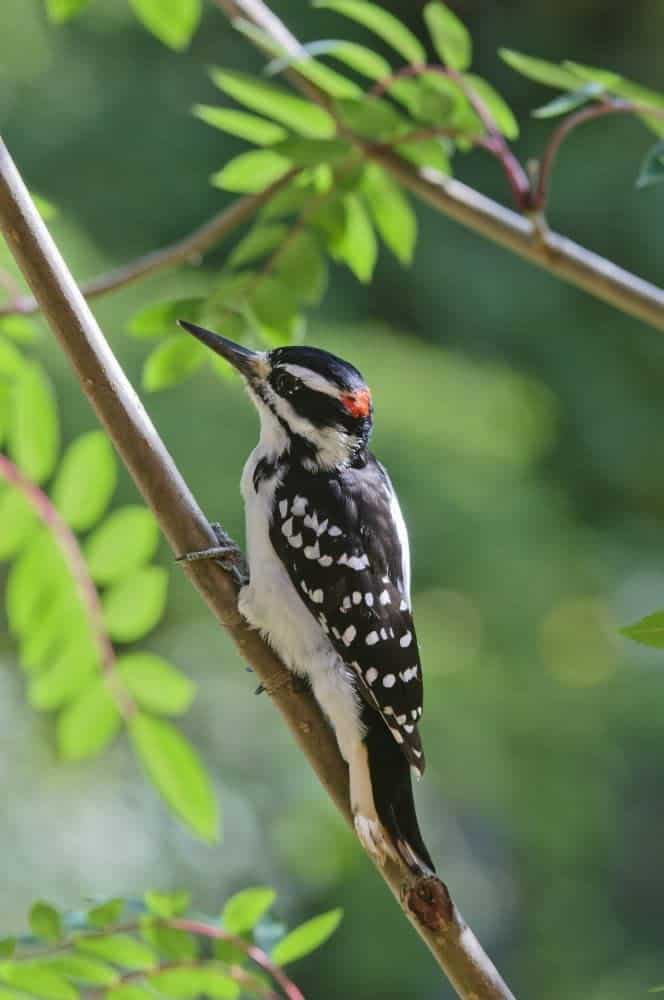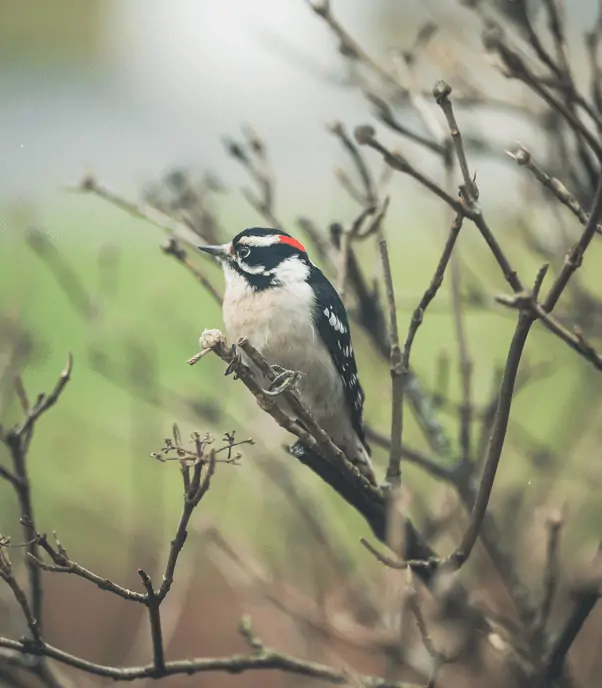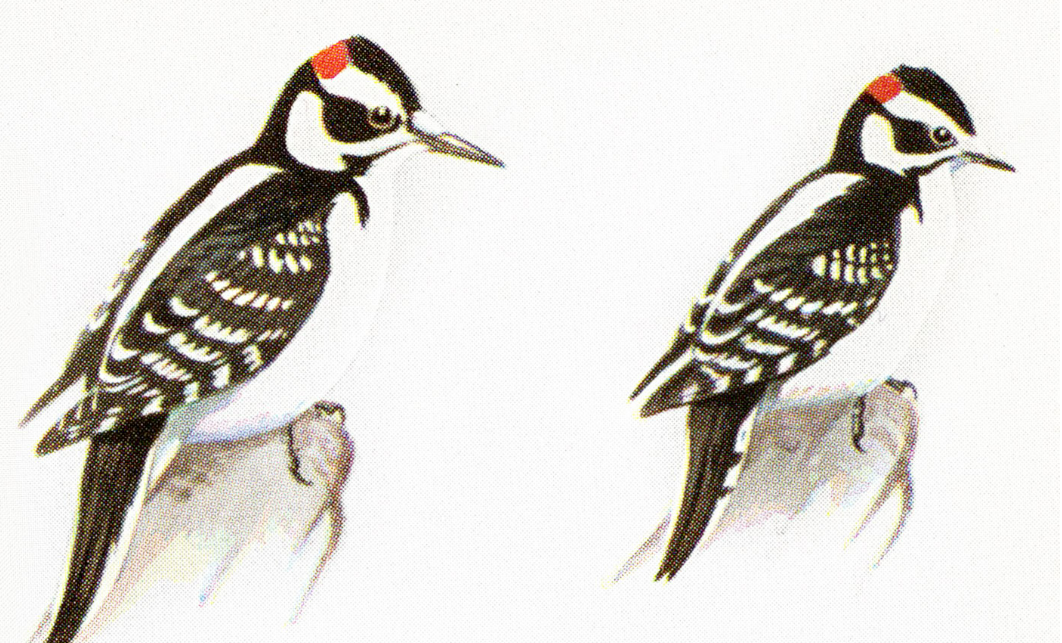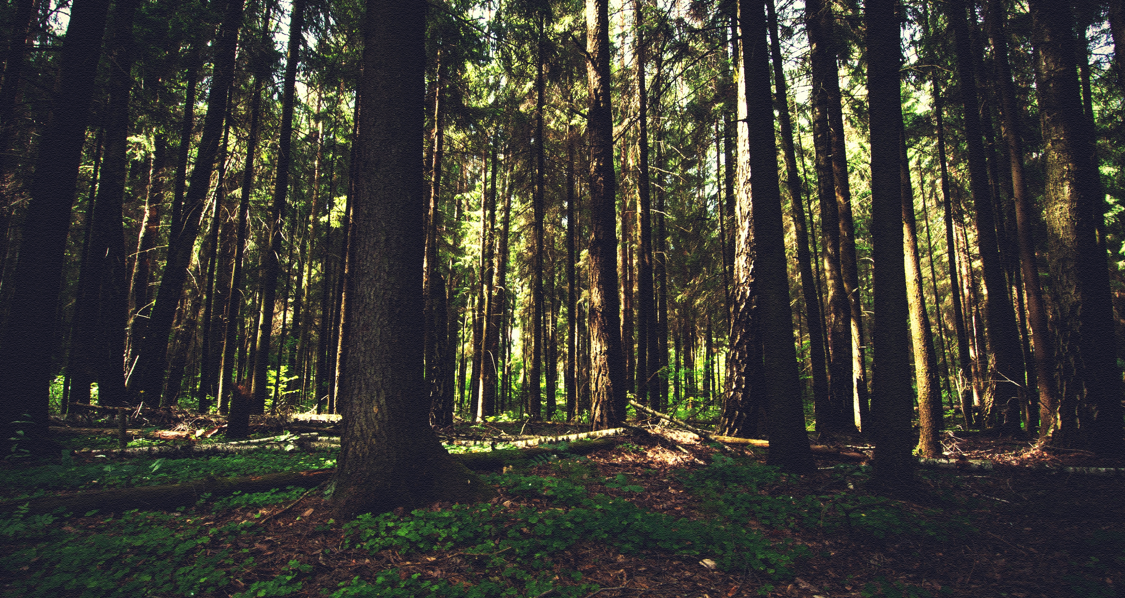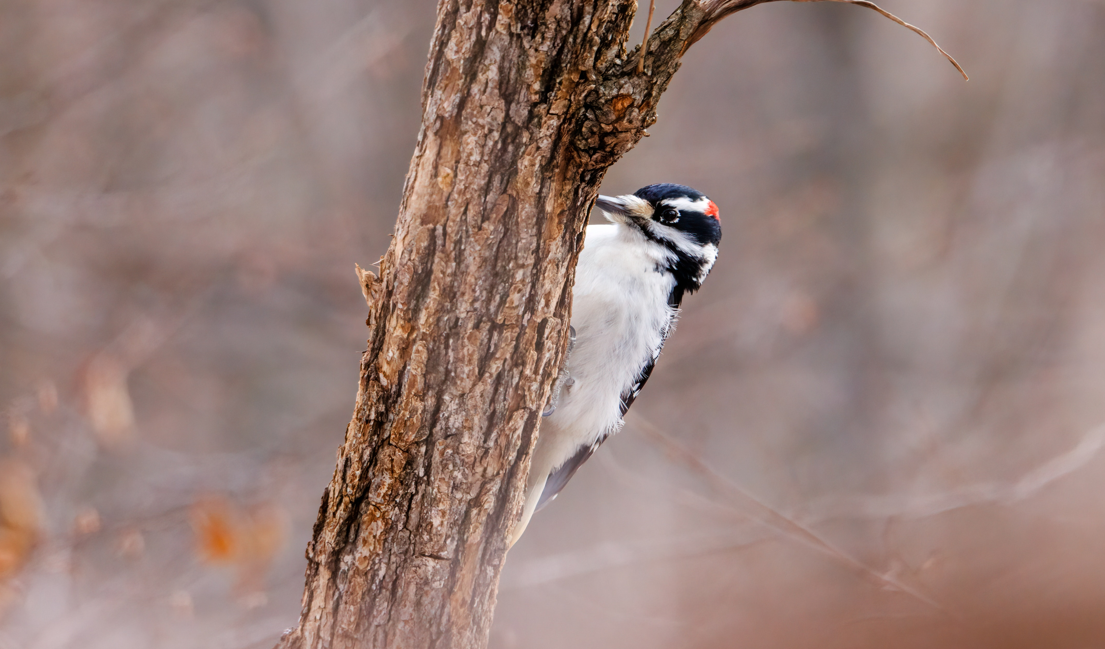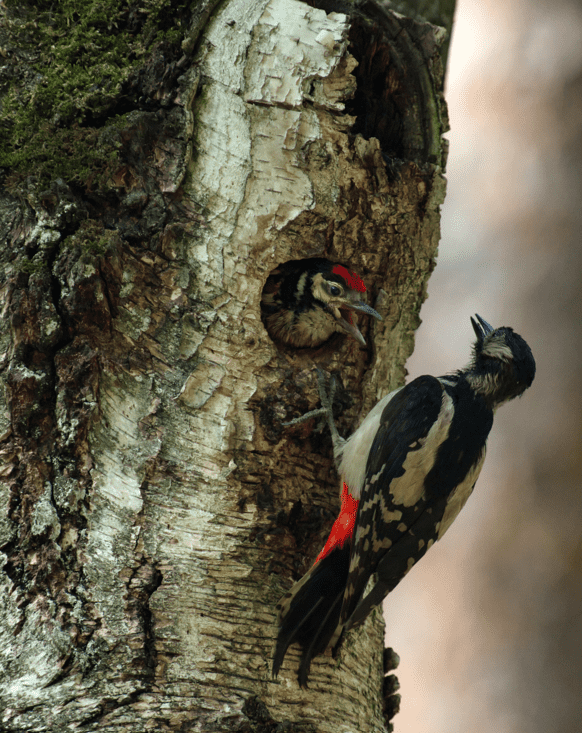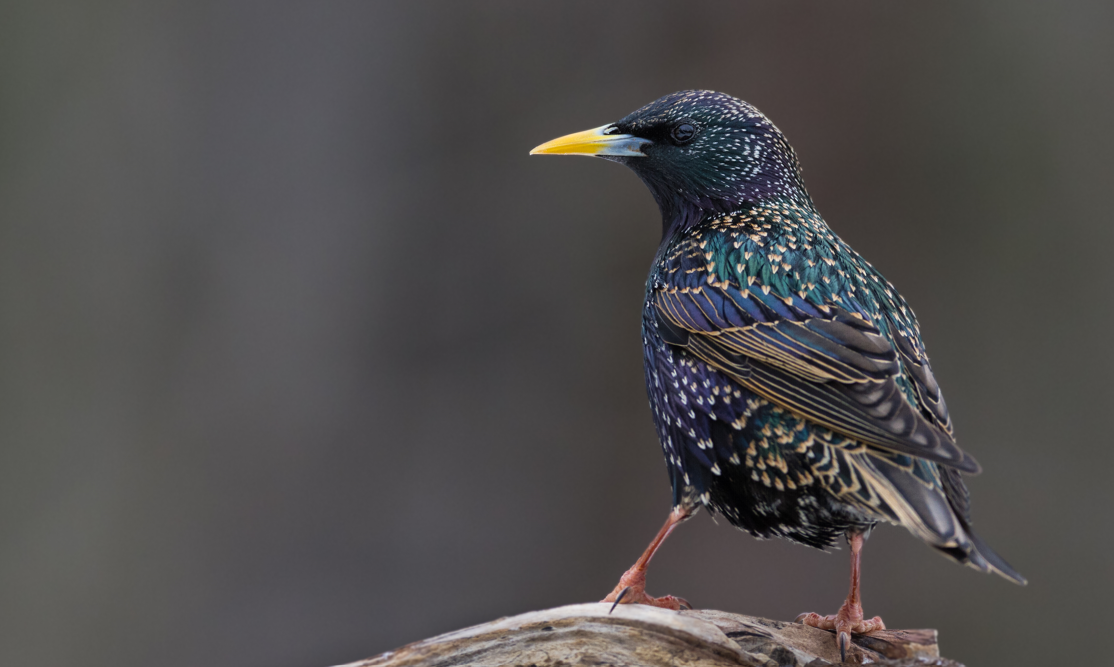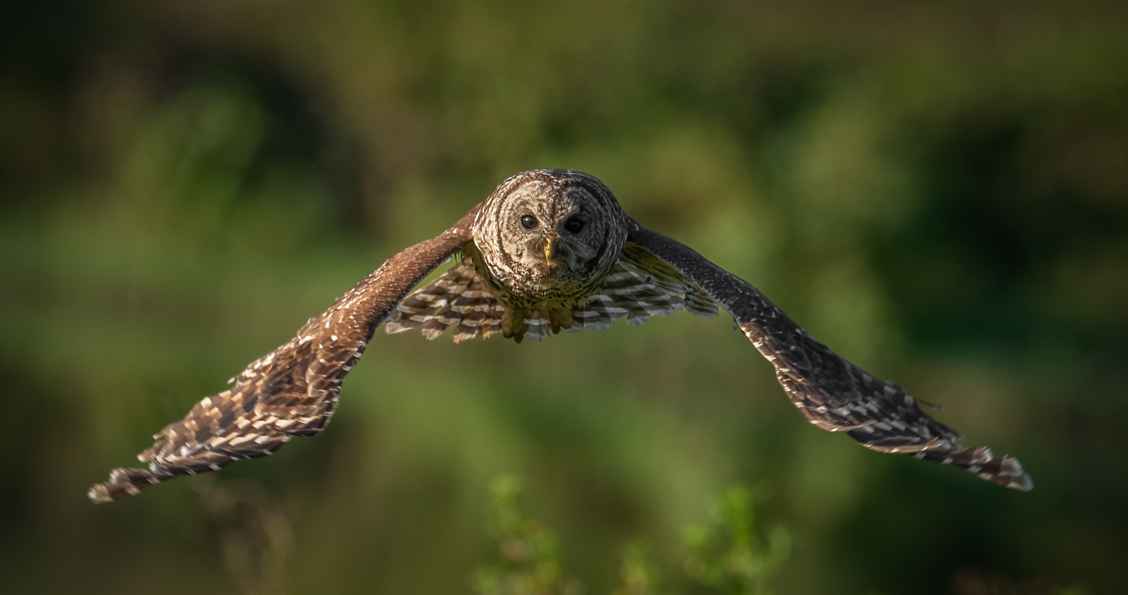- Amethyst-throated Mountain-Gem Guide (Lampornis amethystinus) - November 24, 2022
- Best Martin Bird House Guide - November 14, 2022
- Best Millet Bird Seed Guide - November 9, 2022
Woodpeckers are perplexing and fascinating birds. They have abrupt expressions, stark bills, and look a bit prehistoric with blocky heads and long stiff tails. I used to acknowledge them and move on casually, but after dedicating some time to observe them intentionally, I couldn’t believe I had overlooked this entertaining and resourceful bird. Never again!
It’s great fun to fall in love with a bird you can see often. Not that you should set the bar low, but by spending time learning about the captivating birds within my area, I’ve been able to make my birdwatching experiences more exciting and meaningful. The Hairy Woodpecker has a considerable year-round distribution range which means your chances of spotting one are better than your chances of seeing that Hyacinth Macaw on your life list.
Taxonomy
The Hairy Woodpecker belongs to the Order Piciformes, which includes woodpeckers and their close zygodactyl relatives such as toucans, barbets, and honeyguides. Looking further into the Hairy Woodpecker’s family Picidae, you’ll also find wrynecks, piculets, and sap suckers.
Foraging behaviors along tree trunks, limbs, and bark is typical in this family, and the use of drumming to communicate territory defense or for mating purposes is another defining characteristic.
How to Identify a Hairy Woodpecker
When in the distribution range of any woodpecker, it’s hard to miss them once you’ve learned the basics. Whether you hear them or see them first, their contrasting black and white coloration, whinnying calls, and drumming can immediately get your attention.
Size and Shape
The Hairy Woodpecker is a robin-sized bird that is roughly seven to ten inches in length, one to three ounces in weight, and has a wingspan of thirteen to sixteen inches.
This bird has a blocky head and a lengthy bill the size of its head that looks like a small but thick nail or thorn. Characteristic of most woodpeckers, the Hairy Woodpecker has signature stiff and long tail feathers that are used to lean and support themselves against trees.
Color Pattern
Most woodpeckers are known for their black, white, and red plumage. The consistency across species makes them easy to initially identify but might require a closer look to ensure you’ve identified the right bird.
The Hairy Woodpecker is black and white throughout its entire body. Its wings have a checkerboard appearance, and its black square head has two bold white stripes. One stripe is above their eye, and one line is below. A thick white verticle stripe goes down the center of its back. A white chest and underparts extend to the bottom of its tail feathers. Males will display a red patch on their nape, and juveniles Hairy Woodpeckers will sometimes show a less noticeable orange coloration on their crown.
Hairy Woodpecker vs. Downy Woodpecker
The Hairy Woodpecker is often mistaken for its lookalike, the Downy Woodpecker; however, a few key distinctions set them apart.
The Downy Woodpecker is smaller by roughly three inches and has a shorter and thinner bill. You are also more likely to see a Downy Woodpecker due to a difference of five million in population numbers. A Downy Woodpecker has white spots along its tail feathers, a feature absent in the Hairy Woodpecker.
Where Does a Hairy Woodpecker Live: Habitat
Hairy Woodpeckers have few qualifications for suitable habitats. The most important one is that there are preferably mature deciduous trees. The safety of well-forested areas gives these birds plenty of feeding and nesting opportunities. However, they are also found along river groves, swamps, and woodlands near prairies.
Their distribution range is vast, and they do not usually migrate unless climates are frigid in the winter. You will find the Hairy Woodpecker year-round across the following countries:
- Canada
- United States
- Mexico
- Honduras
- Nicaragua
- Costa Rica
- El Salvador
- Guatemala
Hairy Woodpecker Diet and Feeding
The Hairy Woodpecker has a diet that consists of insects, fruit, and seeds which is in line with most woodpecker species. Seventy-five percent of their diet comprises insects such as larvae of wood boring beetles and bark beetles, caterpillars, ants, and moth pupae. Other menu items include grasshoppers, spiders, and flies.
This diet benefits trees as much as it does Hairy Woodpeckers. Wood boring beetles cause immense damage to the thousands of trees they inhabit. If an infestation occurs, the tree will most certainly die. When large quantities of boring beetles are present, Hairy Woodpeckers and other woodpecker species are usually close behind to do damage control while getting an easy meal.
In orchards, the sign of woodpeckers can be a signifier that an outbreak of codling moths has occurred. Luckily, woodpeckers have been known to control these outbreaks, giving trees a second chance.
The Hairy Woodpecker’s Tongue: A Resourceful Tool
Food is acquired through foraging on trees, in plants, along vines, and on the ground. The Hairy Woodpecker taps and probes tree bark as it hops along the branches and around the trunk. Underneath bark, delicious larvae await to be snatched up by the woodpecker’s insanely fascinating barbed tongue.
You might wonder how a woodpecker can hammer away at a tree and not end up with a concussion. Well, the answer is their tongue. The hyoid bone, or bone the tongue muscle is attached to, begins in the woodpecker’s nostrils on the upper portion of their bill. The muscle-wrapped bone extends from the nostril, between the eyes, and across the top of the skull, where it diverges into two. The two vein-like strands continue around the back of the skull and eventually converge at the bottom half of the bill, where it enters the woodpecker’s mouth. Each time the woodpecker extends its long barbed tongue to catch insects, it unfurls from the base of the hyoid to give it tremendous length. The length of a woodpecker’s tongue depends on the species, but on average, their tongues extend two to five inches past the tip of their bills.
In addition to giving the bird an advantage at lunchtime, the muscle-wrapped hyoid bone works double-duty by serving as a protective cushion for their brain. This means they can rapidly peck until their heart is content and sustain no injuries.
Hairy Woodpecker Breeding
The breeding season for Hairy Woodpeckers ranges from February to June, with peak season in April and May. To prepare for the breeding season, woodpeckers must find a suitable mate. During the winter, a male will scout out his ideal territory. Once selected, he will drum on a post, tree trunk, or metal to invite interested females. Females will confirm interest by returning the drum, letting the male know she is near.
As the pair meets, continuous drumming is performed by both sexes for several days and sometimes weeks. A display of courtship flight may take place as well. During the courtship flight, each woodpecker will clap their wings against their side or flutter its wings rapidly. From this point on, the nesting process begins.
A mating pair of Hairy Woodpeckers is monogamous and may last for life. However, some mating couples may occupy separate territories, only finding each other at the start of the breeding season.
Hairy Woodpecker Nesting
The male performs an impressive excavation of a dead tree branch or trunk in an orchard or forest approximately four to sixty feet off the ground. A method to deter sap suckers and other competition from stealing their nesting location is to place a nesting cavity in a limb that is not verticle to the tree trunk. Holes are two inches tall, one and a half inches wide, and eight to twelve inches deep. At the bottom, a modest pile of woodchips is left behind to act as bedding for the chicks. During the excavation process, egg laying is less than two weeks away.
Hairy Woodpecker Eggs
The female Hairy Woodpecker lays between three to six eggs per clutch to produce one brood. Both parents incubate the eggs for fourteen days. Once hatched, both parents also feed the nestlings. Hatchlings leave the nest after twenty-eight to thirty days and remain reliant on their parents for food for a few weeks longer. Males may travel greater distances while foraging, collecting more food to make fewer trips.
Hairy Woodpecker Population
The current population of Harry Woodpeckers is estimated to be about 8.9 million by the North American Breeding Bird Survey and Partners in Flight. It rates a six out of twenty on the Continental Concern Score. This rating means the species is stable and has a low conservation concern.
Is Hairy Woodpecker Endangered?
The Hairy Woodpecker is not endangered. However, the lack of suitable nesting sites and competition from the European Starling remains a concern for the species.
European Starlings and Woodpeckers: A History of Rivalry
Starlings are mortal enemies of almost all woodpecker species. They are drawn to freshly excavated woodpecker nesting cavities and will do anything to steal the site. The war between them has been waged for thousands of years in the starlings’ native territory of Europe. So, European woodpeckers are no stranger to this behavior. The startling was released in North America in 1890 by a group of Shakespear enthusiasts that believed every bird ever mentioned by Shakespear should have a home in America. Since their release, they have grown to a population of nearly 200 million. This bird wreaks havoc on other birds, planes, and farmland. They even have corrosive waste droppings, and their massive flock sizes mean LOTS of waste droppings.
Starlings have aggressive tendencies that generally prevail when fighting over a nesting cavity. Although some woodpecker species have large pointy bills that could kill a combative starling, the woodpecker will typically submit. The most aggressive woodpeckers are the Red-headed woodpeckers and Flickers. They will generally stand their ground throughout the fight. However, their short legs and lack of instinctual aggression are a disadvantage against the fighting machine that is the starling.
Starlings have learned tactics to remove woodpeckers without fighting, too. Starlings will engage in combative behavior from afar when they’ve spotted a coveted nesting cavity. A woodpecker may chase the starling away, leaving the entrance to the hole unguarded. The starling will swoop in, claiming the territory as their own. Suppose they can enter the nesting cavity with the adult woodpecker present. In that case, a startling will begin to fight inside the nest, usually pinning the woodpecker on the bottom and pecking it, sometimes to death.
Hairy Woodpecker Habits
The Hairy Woodpecker stays on course as it rapidly pecks, flutters, and hops around on its mission for food. If it is disturbed or feels threatened, it turns to its playbook of natural responses.
When faced with conflict, the Hairy Woodpecker will raise its wings and cock its head back while letting out a shrieking call. Wing fluttering followed by a quick “brrrrup” noise is also common. Drumming is displayed to fend off intruders and claim territory. Other aggressive displays from this woodpecker include pointing its bill, head bobbing, wing spreading, and raising its crest. If the Hairy Woodpecker would like to display submission, it will simply outstretch the feathers of its tail to send the message.
Hairy Woodpecker Predators
Predators can attack in many different ways. Whether it’s nest raiding, egg sabotage, or serving as a meal, the Hairy Woodpecker has enemies in all categories.
Adult Hairy Woodpeckers must be vigilant against other birds such as the Great-horned Owls, Eastern Screech Owls, Barred Owls, Northern Goshawk, and Cooper’s Hawk. These animals may prey on adults, juveniles, or eggs. Non-bird predators include foxes, snakes, and badgers.
Predators near the nest are a result of competition for nesting sites. Birds that will poke holes in eggs and steal nests are the Red-bellied Woodpecker, House Sparrow, and European Starling.
Hairy Woodpecker Lifespan
The general lifespan for a Hairy Woodpecker is between four and fifteen years. The oldest known Hairy Woodpecker was fifteen years and eleven months old. Old age is typical in captivity, but like most birds, their chances of longevity increase once they make it past the first year of life.
Attract Hairy Woodpeckers
Woodpeckers are lovely to have around. They are entertaining to watch, fun to listen to, and eat insects that may cause damage to your trees and home. To create a woodpecker-friendly yard, consider the following recommendations regarding food, water, shelter, and nesting sites.
Food
Now that you know more about a woodpecker’s diet, use this to your advantage. They are likely to visit feeders with mealworms and in seasons where insects are few and far between, like winter, be sure not to skimp on the nutritious addition. Fatty suet, black oil, sunflower seeds, peanuts, and peanut butter will also score you points with Hairy Woodpeckers.
It is essential to use feeders with good tail props. Woodpeckers use their long stiff tails as a kickstand when leaning against trees, and feeders with ample space to rest comfortably are ideal. If you have a suet feeder without a tail prop, make it woodpecker friendly by placing it on the trunk of a mature tree. Wood piles, stumps, and downed limbs are great foraging opportunities for woodpeckers, so leaving them undisturbed will also increase your chances.
Water
Believe it or not, this boisterous and flashy bird is relatively private regarding bird baths. They prefer a shallow basin on the ground with shade and tree coverage instead of traditional pedestal bird baths. Adding a small water fountain to the basin will make it easily noticeable. Be mindful of the outdoor temperature and incorporate heaters when necessary.
Shelter and Nesting Sites
If you have a dead tree in your yard that does not pose a safety risk to your home, neighbors, or property, consider leaving it! This makes a beautiful roosting spot for woodpeckers. It may feel like planting trees is pointless since it will be years before they are mature enough to host woodpeckers. However, thinking ahead and planning for future generations of birds is valuable to a species faced with habitat loss. If you go this route, pine, oak, sweet gum, and birch trees are highly favored by woodpeckers.
Incorporating nesting boxes and bird houses in your yard is great for attracting more than just woodpeckers. To make these boxes woodpecker-friendly, add some woodchips to the base of the empty box and consider adding a predator guard. Boxes should be mounted ten to twenty feet from the ground for more excellent success. Don’t forget to clean nesting boxes at the end of each breeding season to welcome the following year’s residents properly.
Be patient. It may take some time for woodpeckers to feel safe visiting feeders, boxes, and bird baths. Keeping these features in less trafficked areas will help speed the acclimation process.
FAQ
Answer: These two birds look incredibly similar. The Hairy Woodpecker will be larger by about fifty percent. The Hairy Woodpecker has a larger bill that looks like a thorn. The Downy Woodpecker is smaller and has a much shorter bill. Other than these critical distinctions, their colors and feather patterns are identical.
Answer: A red patch is visible on the nape of male Hairy Woodpeckers. Females will not have a red nape. Juveniles may have some orange-red coloring on the nape.
Answer: Hairy Woodpeckers got their name from the delicate and long white feathers prominently featured across their backs. They contrast against black plumage making them hard to miss.
Answer: Woodpeckers will continue to peck, drum actively, and drill at daybreak. Early morning birdwatching will help you observe this behavior. Having light is an essential requirement for woodpeckers to drum or drill. When no light is present, they will refrain from this activity.
Research Citations
- Audubon. (2014, November 13). Hairy Woodpecker. Retrieved from Audubon website: https://www.audubon.org/field-guide/bird/hairy-woodpecker
- Cornell Lab of Ornithology. (n.d.). Hairy Woodpecker Overview, All About Birds, Cornell Lab of Ornithology. Retrieved from www.allaboutbirds.org website: https://www.allaboutbirds.org/guide/Hairy_Woodpecker/overview
- Encyclopedia Britannica. (n.d.). Hairy Woodpecker Skull. Retrieved July 22, 2022, from www.britannica.com website: https://www.britannica.com/animal/hairy-woodpecker
Looking for more interesting readings? Check out:


